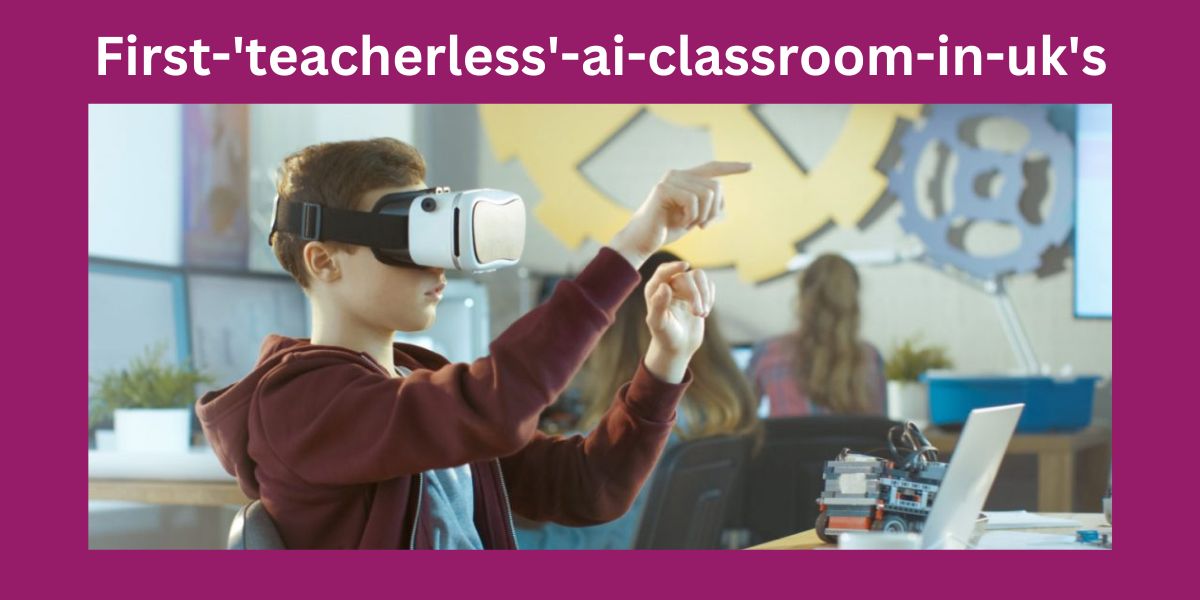The world of education is about to experience a revolutionary change with the opening of the UK’s first ‘teacherless’ AI classroom in London. Yes, you read that right—no teachers, just artificial intelligence guiding the students. This groundbreaking development is expected to change the way we think about teaching and learning. But what exactly does a ‘teacherless’ classroom look like? How will it work? And what could it mean for the future of education? Let’s dive in and explore these questions in detail.
What is a ‘Teacherless’ AI Classroom?
Understanding the Concept
At its core, a ‘teacherless’ AI classroom is an educational environment where artificial intelligence takes over the role traditionally filled by a human teacher. Instead of a person standing at the front of the room delivering lectures, AI software would handle everything—from delivering lessons to providing personalized feedback and even grading assignments. Imagine walking into a classroom where the only interaction you have is with a computer screen or a robot. Sounds like a scene straight out of a sci-fi movie, right? Well, it’s becoming a reality.
How AI Replaces Human Teachers
AI in these classrooms isn’t just about replacing teachers; it’s about enhancing the learning experience. AI algorithms can analyze each student’s learning style, strengths, and weaknesses to provide a tailored educational experience. The AI can adapt the curriculum in real-time, ensuring that every student progresses at their own pace. Think of it like having a personal tutor for every single student, but instead of a person, it’s a sophisticated software system doing all the work.
The Benefits of AI-Powered Classrooms
Personalized Learning Experience
One of the most significant advantages of AI-powered classrooms is the ability to offer personalized learning experiences. Each student learns differently, and AI can cater to these individual needs. Whether a student needs extra help in mathematics or is excelling in science and needs more challenging material, AI can adapt to these needs instantaneously.
24/7 Availability
Another key benefit is the availability of learning resources 24/7. Unlike traditional classrooms, where learning is confined to school hours, AI classrooms allow students to learn at any time. Have a question at midnight? No problem. The AI is always there to provide answers and guidance.
Reducing Teacher Burnout
Teacher burnout is a real issue in many educational systems. With AI taking over some of the more repetitive and administrative tasks, human teachers can focus on what they do best: inspiring and mentoring students. By offloading tasks like grading and attendance, AI can help reduce the workload for human educators.
Challenges and Concerns
Ethical Implications
While the idea of a ‘teacherless’ classroom sounds futuristic and exciting, it also raises some ethical concerns. For one, the human touch is an essential part of education. Can AI ever truly replace the empathy, understanding, and moral guidance that human teachers provide? What happens to the emotional development of students when they only interact with machines?
Data Privacy Concerns
Another significant challenge is data privacy. AI systems rely heavily on data to function effectively. This means collecting and analyzing vast amounts of information about students’ behaviors, learning patterns, and even personal details. How will this data be protected? Who has access to it? Ensuring that students’ data remains private and secure is a major hurdle that needs to be addressed.
The Risk of Over-Reliance on Technology
There’s also the concern of becoming too dependent on technology. What if the system malfunctions? Or worse, what if it gets hacked? Relying solely on AI for education could potentially lead to vulnerabilities that might disrupt the entire learning process.
How Will the ‘Teacherless’ Classroom Work?
The Role of AI Tutors
In the UK’s first AI-powered classroom, AI tutors will be the primary source of instruction. These tutors will use advanced machine learning algorithms to understand each student’s needs. They will deliver lessons through interactive screens, virtual reality, and other digital mediums. Students can ask questions, get instant feedback, and even participate in virtual group discussions.
The Learning Environment
These classrooms will be equipped with cutting-edge technology—think smart boards, interactive tablets, and VR headsets. The aim is to create an immersive learning experience that keeps students engaged and motivated. Traditional desks and chairs might be replaced with more flexible seating arrangements that encourage collaboration and interaction.
Monitoring and Assessment
AI systems will constantly monitor students’ progress. They can track how well a student understands a topic, how long it takes to complete assignments, and even identify patterns in behavior that might indicate a student is struggling. This data will be used to provide real-time feedback and adjust the curriculum as needed.
What Does This Mean for the Future of Education?
Redefining the Role of Teachers
The introduction of ‘teacherless’ AI classrooms doesn’t necessarily mean the end of human teachers. Instead, it could redefine their role. Teachers could shift from being information providers to becoming mentors and facilitators. They could spend more time on activities that promote critical thinking, creativity, and emotional intelligence.
Preparing Students for the Digital Age
As we move further into the digital age, having AI in classrooms could better prepare students for the future workforce. Learning to interact with AI, understanding how it works, and being able to adapt to technological advancements are skills that will be highly valuable in the coming years.
Bridging the Education Gap
AI classrooms could also help bridge the education gap. In areas where there is a shortage of qualified teachers, AI could provide a consistent and high-quality education. This technology could make learning more accessible to students who otherwise might not have access to specialized courses or personalized tutoring.
The Road Ahead: Embracing Change
The Importance of Pilot Programs
Before AI classrooms become mainstream, pilot programs will be crucial. Testing these environments on a smaller scale will allow educators to identify potential issues and make necessary adjustments. London’s first AI-powered classroom will serve as an important case study for the rest of the world.
Collaboration Between Tech Companies and Educators
For AI classrooms to be successful, collaboration between technology companies and educators is essential. Tech companies need to understand the needs of students and teachers, while educators need to be open to integrating new technologies into their teaching methods.
Continuous Improvement and Updates
AI is constantly evolving, which means that the AI systems used in classrooms will need regular updates and improvements. This ongoing development will ensure that the technology remains effective and continues to meet the needs of students.
Conclusion
The opening of the UK’s first ‘teacherless’ AI classroom in London is a bold step towards the future of education. While it offers numerous benefits, such as personalized learning and reduced teacher burnout, it also presents challenges that need careful consideration. Ethical implications, data privacy concerns, and the risk of over-reliance on technology are all issues that need to be addressed. As we embark on this new educational journey, it’s crucial to strike a balance between embracing technological advancements and maintaining the human elements that are so vital to learning. Only then can we create a learning environment that is both innovative and nurturing.
FAQs
1. Will AI completely replace human teachers?
No, AI is not expected to completely replace human teachers. Instead, it will supplement traditional teaching methods and allow educators to focus more on mentorship and fostering emotional intelligence in students.
2. How will students’ data be protected in AI classrooms?
Data privacy is a major concern. AI systems will need to comply with strict data protection regulations to ensure students’ information is kept secure. Transparency in data usage policies will be key.
3. Can AI handle all subjects equally well?
While AI is excellent for subjects that require pattern recognition, like mathematics and science, it may not be as effective in subjects that require creative thinking and emotional engagement, such as literature and art.
4. What happens if the AI system malfunctions?
Backup systems and traditional teaching methods will be in place to ensure that learning is not disrupted. It is crucial to have contingency plans for any technical issues.
5. How can students and parents be assured of the quality of education in AI classrooms?
Quality assurance will involve regular monitoring and evaluation of the AI systems by educational experts. Feedback from students, parents, and educators will also be vital in continually improving the AI classroom experience.










